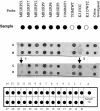Detection of mutations associated with isoniazid and rifampin resistance in Mycobacterium tuberculosis isolates from Samara Region, Russian Federation
- PMID: 15472300
- PMCID: PMC522290
- DOI: 10.1128/JCM.42.10.4498-4502.2004
Detection of mutations associated with isoniazid and rifampin resistance in Mycobacterium tuberculosis isolates from Samara Region, Russian Federation
Abstract
High incidence rates of isoniazid-, rifampin-, and multiple-drug-resistant tuberculosis have been reported in countries of the former Soviet Union (FSU). Genotypic (unlike phenotypic) drug resistance assays do not require viable cultures but require accurate knowledge of both the target gene and the mutations associated with resistance. For these assays to be clinically useful, they must be able to detect the range of mutations seen in isolates from the population of tuberculosis patients to which they are applied. Two novel macroarrays were applied to detect mutations associated with rifampin (rpoB) and isoniazid (katG and inhA) resistance. In a sample of 233 isolates from patients in Samara, central Russia, 46.5% of isolates possessed mutations in both the rpoB and the katG (or inhA) genes. Combined results from the macroarrays demonstrated concordance in 95.4 and 90.4% of phenotypically defined rifampin- and isoniazid-resistant isolates, respectively. The contribution of different mutations to resistance was comparable to that reported previously for non-FSU countries, with 90% of rifampin-resistant isolates and 93% of isoniazid resistant isolates due to rpoB531 and katG315 mutations, respectively. The percentage of phenotypically resistant rifampin isolates with no mutations in the rpoB codons 509 to 536 was 4.2%, which was similar to previous reports. Novel macroarrays offer a rapid, accurate, and relatively cheap system for the identification of rifampin-, isoniazid-, and multiple-drug-resistant Mycobacterium tuberculosis isolates.
Figures

References
-
- Agerton, T. B., S. E. Valway, R. J. Blinkhorn, K. L. Shilkret, R. Reves, W. W. Schluter, B. Gore, C. J. Pozsik, B. B. Plikaytis, C. Woodley, and I. M. Onorato. 1999. Spread of strain W, a highly drug-resistant strain of Mycobacterium tuberculosis, across the United States. Clin. Infect. Dis. 29:85-92. - PubMed
-
- Alvarado-Esquivel, C., R. Rossau, S. Martinez-Garcia, J. A. Cisneros-Martinez, W. Mijs, A. Nevarez-Najera, R. Fierro-Campa, M. F. Mercado-Suarez, S. Hernandez-Campos, R. Chacon-Arciniega, J. Vazquez, G. Saucedo-Martinez, and R. Ruiz-Astorga. 2001. Characterization of rpoB gene mutations in rifampicin resistant Mycobacterium tuberculosis strains isolated from pulmonary tuberculosis patients at 5 Mexican public hospitals. Rev. Invest. Clin. 53:526-530. - PubMed
-
- Bártfai, Z., Á. Somoskövi, C. Ködmön, N. Szabó, E. Puskás, L. Kosztolányi, E. Faragó, J. Mester, L. M. Parsons, and M. Salfinger. 2001. Molecular characterization of rifampin-resistant isolates of Mycobacterium tuberculosis from Hungary by DNA sequencing and the line probe assay. J. Clin. Microbiol. 39:3736-3739. - PMC - PubMed
-
- Bodmer, T., K. Zurcher, P. Imboden, and A. Telenti. 1995. Mutation position and type of substitution in the β-subunit of the RNA polymerase influence in-vitro activity of rifamycins in rifampicin-resistant Mycobacterium tuberculosis. J. Antimicrob. Chemother. 35:345-348. - PubMed
-
- Breathnach, A. S., A. de Ruiter, G. M. Holdsworth, N. T. Bateman, D. G. O'Sullivan, P. J. Rees, D. Snashall, H. J. Milburn, B. S. Peters, J. Watson, F. A. Drobniewski, and G. L. French. 1998. An outbreak of multi-drug-resistant tuberculosis in a London teaching hospital. J. Hosp. Infect. 39:111-117. - PubMed
Publication types
MeSH terms
Substances
LinkOut - more resources
Full Text Sources
Other Literature Sources

